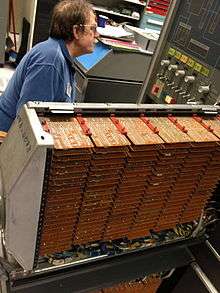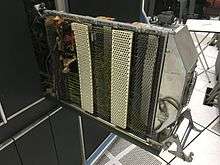IBM Standard Modular System


The Standard Modular System (SMS) was a system of standard transistorized circuit boards and mounting racks developed by IBM in the late 1950s, originally for the IBM 7030 Stretch.[1] They were used throughout IBM's second generation computers, peripherals, the 7000 series, the 1400 series, and the 1620. SMS was superseded by Solid Logic Technology (SLT) introduced with System/360 in 1964, however they remained in use with legacy systems through the 1970s.
Many IBM peripheral devices that were part of System/360, but were adapted from second-generation designs, continued to use SMS circuitry instead of the newer SLT. These included the 240x-series tape drives and controllers, the 2540 card reader/punch and 1403N1 printer, and the 2821 Integrated Control Unit for the 1403 and 2540. A few SMS cards used in System/360 peripheral devices even had SLT-type hybrid ICs mounted on them.
SMS cards were constructed of individual discrete components mounted on single-sided paper-epoxy printed circuit boards. Single-width cards were 2.5 inches wide by 4.5 inches tall by 0.056 inches thick, with a 16 pin gold plated edge connector. Double width cards were 5.375 inches wide by 4.5 inches tall, with two 16 pin gold plated edge connectors. Contacts were labeled A–R (skipping I and O) on the first edge connector, and S–Z, 1–8 on the second.
The cards were plugged into a card-cage back-plane and edge connector contacts connected to wire wrap pins. All interconnections were made with wire-wrapped connections, except for power bus lines. The back-plane wire-wrap connections were mostly made at the factory with automated equipment, but the wire-wrap technology facilitated field-installation of engineering changes by customer engineers.
Some card types could be customized via a "program cap" (a double rail metal jumper bar with 15 connections) that could be cut to change the circuit configuration. Card types with a "program cap" came with it precut for the standard configuration and if a customer engineer needed a different configuration in the field he could make additional cuts as needed. This feature was intended to reduce the number of different card types a customer engineer had to carry with him to the customer's site.
The card type was a two to four letter code imbossed on the card (e.g., MX, ALQ). If the card had a "program cap" the code was split into a two letter card type code and a two letter "cap connection" code (e.g., AK ZZ).
When SMS was originally developed, IBM anticipated a set of a couple hundred standard card types would be all that would be needed, making design, manufacture and servicing simpler. Unfortunately that proved far too optimistic as the number of different SMS card types soon grew to well over 2500. Part of the reason for the growth was that multiple digital logic families were implemented (ECL, RTL, DTL, etc.) as well as analog circuits, to meet the requirements of the many different systems the cards were used in.
-

SMS card from an IBM 1401
-

Circuit side of same SMS card
-

Another 1401 SMS card, this one with power transistors. It was used to drive print hammers on an IBM 1403 line printer.
-

IBM 1401 card cage
-

Wire wrapped backplane the same card cage
-

IBM 7070 card cage
References
- ↑ Boyer, Chuck (April 2004). "The 360 Revolution" (PDF). IBM. p. 18. Retrieved 25 November 2013.
External links
- Customer Engineering Instruction-Reference, Standard Modular System PDF
- IBM's Standard Modular System (SMS) cards
- http://ibm-1401.info/index.html
- IBM SMS Cards Database